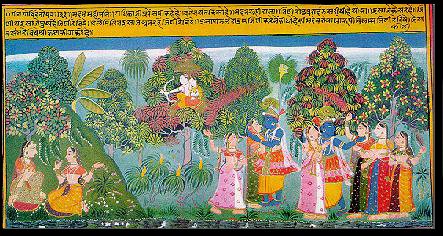Tweet

"Madana mahipati...Sri Krsna krida kara rahe hen."
"Gleaming saffron pistils
are golden sceptres of love.
The wanton bees on trumpet flowers
are arrows in love's quiver."
The sakhi continues with her description of Krsna's dance. An involved simile creates a symphony of color. The red of the flame of the forest is replaced by the saffron flower pistils and the yellow trumpet flowers. The Hindi translation is not only faithful, it is explanatory. It paraphrases both the saffron pistils and the golden sceptre of love and refers to the colors kesan (saffron-orange) and sona (golden).
In the painting Radha and the sakhi sit on a slope, with flowering creepers falling upon them. The flowering creepers are also like the arrows of love. However, the phrase madana mahipati is portrayed by depicting not only Kama, but also Rati, complete with an umbrella (chatra), mentioned in the Hindi text. The pair is hidden in the trees, almost as if to suggest that in fact it is the pistils of the saffron which are the arrows of love. The blue of Madana and the gold of Rati are contrasted. The allusion to the trumpet-like flowers (patali) and the wanton bees are recreated through the group of plants closest to Radha and the sakhi. Krsna is seen in two groups. In the first, he embraces one gopi. In the second, He points to Kama and Rati above, and embraces one sakhi and fondles the face of another. The first is visualisation of the description of the particular verse, the second is the refrain.
It is important to note that the artist takes great pains in conveying pictorially each single verbal image. The details of costumes, coiffures, figurative drawing are important, but the key motivation of the composition lies in the artist's aspiration to make the painting as perfect as the verse. To achieve this end, he takes the verse phrase by phrase, sometimes word by word, and weaves his picture. Where the verse runs on with a continuous simile or metaphor he doesn't divide the painting into multiple spatial areas. Where more than one or two ideas are used, he employs trees or lines as dividers. He is also faithful to the color scheme described in the poem.

